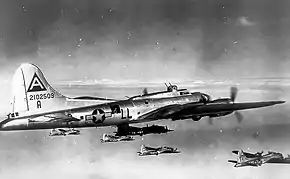701st Tactical Air Support Squadron
The 701st Tactical Air Support Squadron is an inactive United States Air Force unit. It was last assigned to the 601st Tactical Air Control Wing at Bergstrom AFB, Texas, where it was inactivated on 31 January 1980.
| 401st Bombardment Squadron | |
|---|---|
 Squadron B-17 Flying Fortress[note 1] | |
| Active | 1942–1945; 1967–1980 |
| Country | |
| Branch | |
| Role | tactical air support |
| Engagements | European Theater of World War II |
| Decorations | Distinguished Unit Citation |
| Insignia | |
| 401st Bombardment Squadron emblem (approved 18 October 1944) |  |
| WW II Group Marking | Triangle A[1] |
| WW II Squadron Code | LL[1] |
During World War II the squadron was active as the 401st Bombardment Squadron and served in combat in the European Theater of Operations. It was awarded two Distinguished Unit Citations for combat in Germany.
History
The squadron was established as the 11th Reconnaissance Squadron, a B-17 Flying Fortress heavy bombardment squadron in early 1942. Shortly after activation, the squadron was redesignated the 401st Bombardment Squadron (Heavy). It trained under Third Air Force in the southeastern United States with final training under Second Air Force in Washington. The squadron deployed with its parent group to the European Theater of Operations (ETO), where it became part of VIII Bomber Command in England,[2] being one of the first heavy bomb squadrons arriving in England.
The 401st flew combat missions over Nazi Germany and Occupied Europe until the German capitulation in May 1945. Most personnel were demobilized in England immediately after the end of the war in Europe, The squadron returned to the United States with a small headquarters staff and was planned to be re-equipped and remanned as a B-29 Superfortress squadron. The Japanese capitulation canceled plans to deploy to the Pacific and the 401st was inactivated in the United States during November 1945.[2]
In 1967, the 701st Tactical Air Support Squadron activated at Bergstrom Air Force Base, Texas to provide light airlift and forward control support for the Tactical Air Control System, the deployable command and control system of Tactical Air Command under the control of Twelfth Air Force. It continued this mission, maintaining readiness to deploy and participating in exercises for the next thirteen years until inactivating early in 1980.
In 1985, the United States Air Force consolidated these squadrons into a single unit, but the unit has remained inactive since consolidation.
Lineage
401st Bombardment Squadron
- Constituted 11th Reconnaissance Squadron (Heavy) on 28 January 1942
- Activated on 15 April 1942
- Redesignated as 401st Bombardment Squadron (Heavy) on 22 April 1942
- Redesignated as 401st Bombardment Squadron, Heavy on 20 Aug 1943[3]
- Inactivated on 7 November 1945[2]
- Consolidated 19 September 1985 with the 701st Tactical Air Support Squadron as the 701st Tactical Air Support Squadron[4]
701st Tactical Air Support Squadron
- Constituted as the 701st Tactical Air Support Squadron and activated on 13 February 1967 (not organized)
- Organized on 3 April 1967
- Redesignated as 701st Tactical Air Support Squadron, Helicopter on 1 January 1971
- Inactivated on 31 January 1980[5]
- Consolidated 19 September 1985 with the 401st Bombardment Squadron[4]
Assignments
- 91st Bombardment Group, 15 April 1942 – 7 November 1945[2]
- Tactical Air Command, 13 February 1967 (not organized)
- 602d Tactical Control Group, 3 April 1967
- 4467th Tactical Air Control Group, 1 July 1969
- 71st Tactical Air Support Group, 1 January 1970
- 602d Tactical Air Control Group (later 602d Tactical Air Control Wing), 1 June 1974 – 31 January 1980
Stations
- Harding Field, Louisiana, 15 April 1942
- MacDill Field, Florida, 16 May 1942
- Walla Walla Army Air Base, Washington, c. 28 June – 24 August 1942
- RAF Kimbolton (AAF-117),[6] England, 13 September 1942 (ground echelon), early October 1942 (air echelon)
- RAF Bassingbourn (AAF-121), England, 14 October 1942 – 23 June 1945
- Drew Field, Florida, 3 July 1945 – 7 November 1945[2]
- Bergstrom AFB, Texas, 3 April 1967 – 31 January 1980[7]
Aircraft
- B-17 Flying Fortress, 1942–1945
Awards
|
|
- Campaigns
|
|
Notes
Notes
- Explanatory notes
- Aircraft is Boeing B-17G-50-BO Flying Fortress, serial 42-102509 *The Liberty Run*. This airplane was shot down by antiaircraft artillery over Leipzig, Germany on 20 July and its crew made prisoners of war. MACR 7274.
- Citations
- Watkins, pp. 34–35
- Maurer, Combat Squadrons, pp. 490–491
- See Robertson, Patsy (May 28, 2010). "Factsheet 91 Operations Group (AMC)". Air Force Historical Research Agency. Retrieved May 9, 2013.
- Department of the Air Force/MPM Letter 662q, 19 Sep 85, Subject: Reconstitution, Redesignation, and Consolidation of Selected Air Force Tactical Squadrons
- See Mueller
- UK Station Numbers are in Anderson.
- Mueller, pp. 19–34
Bibliography
![]() This article incorporates public domain material from the Air Force Historical Research Agency website http://www.afhra.af.mil/.
This article incorporates public domain material from the Air Force Historical Research Agency website http://www.afhra.af.mil/.
- Anderson, Capt. Barry (1985). Army Air Forces Stations: A Guide to the Stations Where U.S. Army Air Forces Personnel Served in the United Kingdom During World War II (PDF). Maxwell AFB, AL: Research Division, USAF Historical Research Center. Retrieved July 7, 2012.
- Maurer, Maurer, ed. (1982) [1969]. Combat Squadrons of the Air Force, World War II (PDF) (reprint ed.). Washington, DC: Office of Air Force History. ISBN 0-405-12194-6. LCCN 70605402. OCLC 72556.
- Mueller, Robert (1989). Air Force Bases, Vol. I, Active Air Force Bases Within the United States of America on 17 September 1982 (PDF). Washington, DC: Office of Air Force History. ISBN 0-912799-53-6.
- Watkins, Robert (2008). Battle Colors: Insignia and Markings of the Eighth Air Force In World War II. Vol I (VIII) Bomber Command. Atglen, PA: Shiffer Publishing Ltd. ISBN 0-7643-1987-6.